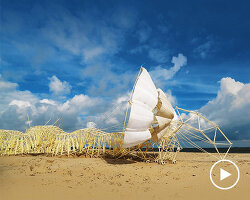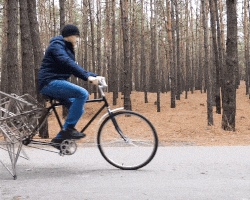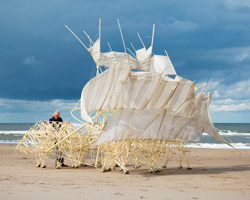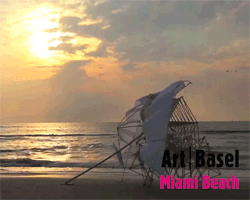STRANDBEESTS BY THEO JANSEN
Each spring, Theo Jansen’s impressive skeletal wind-powered structures take to the beach to provide an update on their evolutionary development.
‘During the summer I do all kinds of experiments with the wind, sand and water,’ said Theo Jansen. ‘In the fall, I grew a bit wiser about how these beasts can survive the circumstances on the beach. At that point I declare them extinct and they go to the bone yard.’
THEY WALKED, NOW THEY FLY
Regularly seen wandering along the Dutch coast, Theo Jansen’s Strandbeests first appeared in 1990. More than simply art objects, Jansen tries to embed actual life into his creations, with the ultimate goal of releasing them to live an independent life in large herds on the beach. He realizes this will not be possible in the near future, but he explained his goal a few years ago in an interview with National Geographic: ‘Give me a few million years and my Strandbeests will live completely independently’.
Jansen’s work over the past years has been about making the creatures more independent. After twelve generations, the creatures are now imposing beasts, several meters long, that move around the beach independently. They are made of PVC tubing that, together with ingenious techniques, use the wind to walk on their own, while flapping their wings.
The Strandbeests were first created as a solution to climate change. In a newspaper, Jansen wrote about the danger of sea-level rise and how his creatures could help churn up the beach and blow the sand onto the dunes to reinforce them. In the most recent period, Jansen has developed the ‘Volantum’ (2020-2021), a Strandbeest that flies.
Watch the video above to see the evolution of the creatures.
Interested in knowing more about Theo Jansen? The Kunstmuseum Den Haag is currently hosting a show dedicated to his career.
project info:
name: Strandbeests
artist: Theo Jansen







